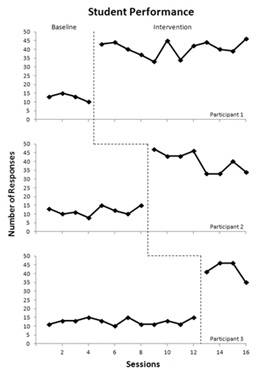


The multiple baseline design is useful for interventions that are irreversible due to learning effects, and when treatment can’t be withdrawn. In this design, behavior is measured across either multiple individuals, behaviors, or settings. Similar to the reversal design, the multiple baseline starts with the baseline (phase A), then proceeds with the intervention (phase B). Yet, the return to the baseline is unnecessary to demonstrate the effect of treatment. Instead, the treatment is applied to another person (as in the graph above), another behavior, or another setting, depending on the variable being manipulated.
There are 3 primary ways multiple baseline designs are implemented. For the multiple-baseline-across-behaviors design, multiple behaviors of the same individual are studied. In the settings design, an individual’s behavior is studied across multiple settings and situations. Lastly, in the multiple-baseline-across-subjects design, the same behavior is studied for multiple individuals.
This design has many advantages. Besides not requiring withdrawal of the intervention, it is fairly easy to conceptualize and is commonly accepted in applied settings by parents and teachers. This design does requires more time and resources to implement because treatment needs to be withheld during the extended baselines of the second and third legs in order to determine if its effects are due to the intervention or simply due to the passage of time. For instance, three participants with a learning disability may be given an identical treatment at different times. This design would test whether the treatment improved school performance or whether the student was struggling with the current material but improved naturally as the school year progressed.
Start making a multiple baseline design graph!
Information source:
Cooper, J. O., Heron, T. E., & Heward, W. L. (2007). Applied behavioral analysis (2nd edition). Upper Saddle River, NJ: Pearson Education, Inc.